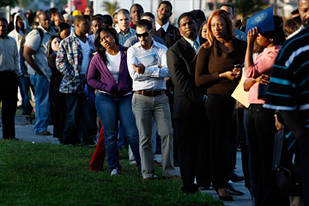
People wait by the thousands in the United States in a hopeless quest for meaningful employment. Despite claims by the Obama administration of a potential recovery, unemployment and home foreclosures continue to rise., a photo by Pan-African News Wire File Photos on Flickr.
Unemployment rate is still far from normal
Douglas A. McIntyre, 24/7 Wall St. 2:18 p.m. EST January 10, 2014
Analysis: Recovery remains remarkably poor, as least as far as job creation is concerned.
December's U.S. jobs additions show an economy that has healed. But compared to the unemployment rate from 1995 though mid-2008, the recovery is remarkably poor, at least as far as jobs are concerned.
Ben Bernanke and the Federal Reserve set a target of 6.5% as the unemployment rate that should trigger an action to set higher interest rates. That action, if the Fed sticks to the number, may come quickly.
However, a really strong economy is measured by a jobless rate of much closer to 5%. Until the rate falls to that level, the recovery has substantial risks.
The unemployment rate in January 1995 was 5.7%, and it remained just above the 5% level until May 1997, when it dropped to 4.9%. It stayed below 5% until September 2001, and reached 3.9% in in the final four months of 2000. There was another run of sub-5% unemployment from December 2005 through late 2007. And the rate did not rise to about 6% until August 2008.
In February 2011, analysts at the Federal Reserve Bank of San Francisco tried to describe unemployment rates of about 6% as the "new normal." By their own admission, their analysis was flawed:
Recent labor markets developments -- including mismatches in the skills of workers and jobs, extended unemployment benefits, and very high rates of long-term joblessness, may be impeding the return to "normal" unemployment rates of around 5%.
An examination of alternative measures of labor market conditions suggests that the "normal" unemployment rate may have risen as much as 1.7 percentage points to about 6.7%, although much of this increase is likely to prove temporary. Even with such an increase, sizable labor market slack is expected to persist for years.
The reasons given for excusing a rate above 5% were all temporary ones, which have persisted since the analysis was done. Long-term joblessness has become a larger problem.
The fight over extended unemployment rates has become more heated as more than one million people lost their benefits at the end of 2013, and millions more are at risk of the same in 2014. The forecast of "labor market slack" has become true.
How much of the larger economy is at risk if the jobless rate stays well above 6%? Traditional economists would argue that the recovery of housing and consumer spending will remain shaky so long as the labor market is slack. To some extent, the revenue of consumer-related businesses cannot recover completely to the health of six years ago. As a matter of fact, the recovery as a whole risks weaknesses that, if job creation deteriorates again only slightly, could drag the national economy back into a "slow growth" mode.
No matter how much cheer there is in a sub-7% unemployment rate, the figure remains much worse than its needs to be for a complete economic recovery.
No comments:
Post a Comment